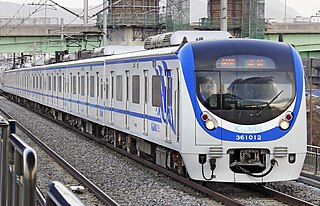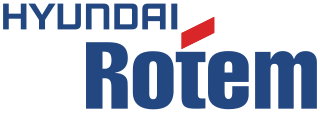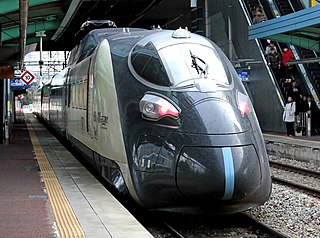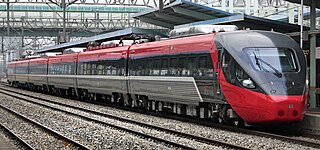
Korea Railroad Corporation, branded as KORAIL, is the national railway operator in South Korea. Currently, KORAIL is a public corporation, managed by Ministry of Land, Infrastructure and Transportation.

The Gyeongchun Line is a regional rail line between Seoul and Chuncheon, South Korea, operated by Korail. Its name is derived from Gyeong and Chuncheon. It was completely reconstructed in the 2000s. Service on it has operated between Sangbong Station on the Jungang Line in eastern Seoul and Chuncheon Station, as part of the Seoul Metropolitan Subway system, since December 21, 2010. A class of regional rail service named ITX-Cheongchun began operations on February 28, 2012, linking Chuncheon to Cheongnyangni and Yongsan Stations.

Korea Train eXpress is South Korea's high-speed rail system, operated by Korail. Construction began on the high-speed line from Seoul to Busan in 1992. KTX services were launched on April 1, 2004.

Hyundai Rotem is a South Korean company manufacturing rolling stock, defense products and plant equipment. It is part of the Hyundai Motor Group. Its name was changed to the current one from Rotem in December 2007 to reflect its parent company.

AREX is a South Korean commuter rail line that links Incheon International Airport with Seoul Station via Gimpo International Airport. The section between the two airports opened on March 23, 2007, the extension to Seoul Station opened December 29, 2010. Korea Train Express high speed trains started to use the line from June 30, 2014 and discontinued in March 2018 due to low ridership.

HSR-350x, alternatively called G7, KHST or NG-KTX, is a South Korean experimental high-speed train. It was developed and built in a joint project of government research institutes, universities and private companies that started in 1996, which aimed to reduce import dependence in high-speed rail technology. New components developed for the HSR-350x included motors, electronics, and the carbody of passenger cars. Test runs were conducted between 2002 and 2008. The experimental train achieved the South Korean rail speed record of 352.4 km/h (219.0 mph) in 2004. The HSR-350x was the basis for Korail's KTX-II (KTX-Sancheon) commercial high-speed trains.
EUROTEM, alternatively Hyundai EURotem, is a joint enterprise between Hyundai Rotem of South Korea and TÜVASAŞ of Turkey which was founded in 2006 and started production in December 2007.

The KTX-Sancheon is a South Korean high-speed train built by Hyundai Rotem in the second half of the 2000s and operated by Korail since March 2009. With a top speed of 305 km/h (190 mph), the KTX-Sancheon is the second commercial high-speed train operated in South Korea and the first domestic high-speed train that is designed and developed in South Korea.

The KTX-I or simply KTX, also known as TGV-K, is a South Korean high speed train class based on the French TGV Réseau. The 20-car formation of the trainsets without restaurant car is optimized for high capacity. The 46 trainsets were built partly in France and partly in South Korea in the framework of a technology transfer agreement, which was the basis for further domestic high-speed train development in South Korea.

HEMU-430X is a South Korean high-speed train intended for a maximum speed of 430 km/h (267 mph). On March 31, 2013, it achieved 421.4 km/h in a test run, making South Korea the world's fourth country after France, Japan and China to develop a high-speed train running above 420 km/h. The main new feature of the train compared to older South Korean high-speed trains is distributed traction. The commercial versions of the trains, tentatively named the EMU-260 and EMU-320, will be delivered to Korail in 2020-2021.

The Suseo–Pyeongtaek high-speed railway or Super Rapid Train (SRT) is a high-speed rail line from Suseo in southeast Seoul to a junction with the existing Gyeongbu high-speed railway in South Korea. To stimulate competition rather than handing operation of the Suseo line to incumbent Korail, a separate company was formed. Today Korail is the primary shareholder, however SRT tickets are not available from the Korail website. In effect there is very little difference between KTX and SRT service s other than the Seoul terminus. Passengers travelling to downtown Seoul will find KTX trains to Seoul Station more convenient. Passengers bound for Gangnam and the area south of the Han River will find SRT trains more convenient. SRT trains offer an alternative Seoul gateway for Gyeongbu KTX and Honam KTX services to Mokpo and Busan at the Seoul end. SRT trains use the same stations as KTX trains in Busan, Mokpo and all other cities.
High-speed rail in East Asia refers to the high-speed rail systems of China, Japan, South Korea and Taiwan, which together are approaching a length of 15,000 km (9,300 mi).

The HRCS2 Hyundai Rotem is a dual-voltage electric multiple unit built by Hyundai Rotem.

The Intercity Train eXpress-Saemaeul is a class of train operated by Korail, the national railroad of South Korea, it was introduced on May 12, 2014, to replace the Saemaeul-ho. The new ITX-Saemaeul trains have a faster average speed of 150 kilometers per hour. The name was taken from the Saemaul Undong after a public competition to determine the new train's name.

The Hyundai Rotem EMU is an upcoming model of heavy rail electric multiple units to be used on the Mass Transit Railway in Hong Kong. The 9-car sets are manufactured by Hyundai Rotem for the future North South Corridor, an extension of the East Rail Line, at a cost of HK$4 billion. 37 trainsets were ordered in December 2012 and the first delivery took place in 2015.. The trains will gradually enter service starting in 2021, and all trainsets will be in service in time for the opening of the Sha Tin to Central Link in 2022, by which time all Metro Cammell EMUs will be retired and SP1900 EMUs withdrawn and reassigned to the East West Corridor.

The LRTA 2000 class is a class of electric multiple units of the Light Rail Transit Authority (LRTA) in Metro Manila, Philippines, which began operation in 2003. It is used in Line 2.
The EMU-320 is a South Korean high-speed electrical multiple unit train manufactured by Hyundai Rotem and operated by Korail.

The Korail Class 210000, also known as the EMU-150, is a South Korean higher-speed electrical multiple unit train manufactured by Hyundai Rotem and Woojin Industrial System Company Limited and operated by Korail on ITX-Saemaeul services since 2014.

The EMU900 series is a series of electric multiple unit passenger trains owned by Taiwan Railways Administration (TRA) that is not yet in operation. Manufactured in South Korea by Hyundai Rotem, the trains will be used on local services which stop at every station.

The EMU600 series is a series of electric multiple unit passenger trains operated by Taiwan Railways Administration (TRA). The trains are built as local trains and are used throughout the island’s rail network.
















